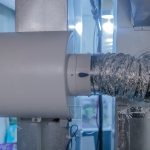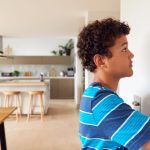Bypass Humidifiers: A Buyer’s Guide
Maintaining the right humidity level in your home is important for comfort and health. When air gets too dry, it can cause problems for you and your house. Bypass humidifiers are a simple solution that work with your heating and cooling system to keep the air just right.
Let’s find out how they help make your home more comfortable.
What is a Whole House Bypass Humidifier?
A bypass whole house humidifier is a type of humidification system designed to work with your home’s existing heating and cooling system (HVAC) to maintain optimal humidity levels throughout the entire house.
It’s called “bypass” because it utilizes a bypass duct to circulate air through a water panel or pad, where the air picks up moisture before being redistributed throughout your home.
This process happens when the air inside your home is drier than what the humidistat, a device that measures humidity, determines is optimal.
Excess water from the humidification process is then directed back into the plenum (a central air distribution space for your HVAC system) via the bypass duct, avoiding over-humidification. This system is particularly effective in cold climates where indoor air tends to be dry, especially during winter months.
It is integrated into the home’s HVAC ductwork and typically installed near the furnace to leverage the existing airflow within the ducts to distribute humidified air.
What are the advantages of using a bypass whole house humidifier?
Using a bypass whole-house humidifier offers several advantages compared to other types of whole-house humidifiers like drum or steam humidifiers:
-
- Energy Efficiency: Bypass humidifiers are generally more energy-efficient than steam humidifiers because they don’t require electricity to generate steam. They utilize the airflow from your existing HVAC system to evaporate water on the humidifier pad, adding moisture to the air without additional energy consumption for evaporation.
- Lower Installation Cost: Compared to steam humidifiers, bypass humidifiers typically have lower initial installation costs. This is because they integrate more simply into existing HVAC systems without the need for independent electrical connections that steam humidifiers might require.
- Low Maintenance: While all humidifiers require maintenance, bypass humidifiers often have a straightforward maintenance routine compared to drum humidifiers. Drum humidifiers have a reservoir of water that can become a breeding ground for bacteria and mold if not cleaned regularly. Bypass humidifiers, which use a flowing water design rather than standing water, typically face fewer issues with microbial growth.
- Effective Humidification for Multi-level Homes: Due to their integration into the HVAC system, bypass humidifiers can effectively distribute humidified air throughout the entire home, including multi-level houses. This can be more efficient compared to portable units or single-room solutions.
- Water Conservation: Bypass humidifiers are designed to recirculate excess water back into the system rather than wasting it. This can be a more water-efficient solution compared to some steam humidifiers that might use more water to generate steam.
- Quiet Operation: Since bypass humidifiers use the air flow from the HVAC system and do not have their own fans or boiling elements, they tend to operate more quietly than steam humidifiers, which may produce noise during the boiling process.
- Compatibility with Existing Systems: Bypass humidifiers are typically compatible with a wide range of HVAC systems and can be a good option for homes with existing forced-air heating and cooling systems. This makes them a versatile choice for many homeowners.
Advantages of Bypass Humidifiers
| Advantage | Explanation |
|---|---|
| Energy Efficiency | Uses existing airflow, no extra energy for evaporation |
| Lower Initial Cost | Less complex than steam systems, so cheaper to install |
| Maintenance | Simpler than drum, less frequent than steam systems |
| Effective for Multi-Level Homes | Uses HVAC ducts to distribute humidity evenly |
| Water Conservation | Recirculates excess water, minimal waste |
| Quiet Operation | No fans or boiling sounds, quieter than steam humidifiers |
| Compatibility | Works with most existing HVAC systems, versatile |
 How does a Bypass humidifier differ from other types of whole house humidifiers?
How does a Bypass humidifier differ from other types of whole house humidifiers?
Bypass humidifiers differ from other types of whole-house humidifiers mainly in their design and operation.
Here’s a comparison with the two other common types: drum and steam humidifiers.
Bypass Humidifiers
-
-
- Operation: Uses the HVAC system’s air flow to move air through a water panel, adding moisture to the air.
- Installation: Integrated into existing HVAC ductwork, often requires less space than steam systems.
- Maintenance: Requires regular maintenance, including annual replacement of the water panel and cleaning.
- Energy Efficiency: Does not require additional electricity to create humidity; it uses the air flow from the HVAC system, making it energy-efficient.
- Cost: Generally lower installation costs compared to steam humidifiers but may be higher than drum systems.
-
Drum Humidifiers
-
-
- Operation: Contains a rotating drum covered with a foam or fabric sleeve that picks up water from a reservoir and evaporates as air blows over it.
- Installation: Installed in the HVAC ductwork similar to bypass but typically easier and cheaper due to fewer parts.
- Maintenance: Higher maintenance due to the risk of mold and bacteria growth in the standing water of the drum.
- Energy Efficiency: Similar to bypass humidifiers in terms of not needing extra electricity for evaporation.
- Cost: Usually the least expensive option in terms of initial investment.
-
Steam Humidifiers
-
-
- Operation: Electrically boils water to create steam, which is then introduced into the ductwork.
- Installation: More complex and can be installed independently of the HVAC system’s operation cycle, making it versatile for different setups.
- Maintenance: Typically less maintenance compared to drum humidifiers but more than bypass since it involves more complex components like heating elements.
- Energy Efficiency: Less energy-efficient due to the electricity needed to boil water, but provides precise humidity control.
- Cost: Higher initial and operational costs due to the complexity of the system and energy usage.
-
Each type of whole-house humidifier offers distinct advantages and potential drawbacks, depending on your home’s specific needs, the climate you live in, and your preferences for maintenance and operational efficiency.
Types of Whole House Humidifiers
| Type | Operation | Installation Complexity | Maintenance Requirements | Energy Efficiency | Cost Implications |
|---|---|---|---|---|---|
| Bypass | Uses airflow from HVAC to evaporate water from a pad | Moderate | Annual pad replacement, regular cleaning | High (no additional energy for evaporation) | Lower installation cost, moderate maintenance cost |
| Drum | Rotating drum absorbs water from a reservoir | Easier | Frequent cleaning due to standing water risks | High (no additional energy for evaporation) | Lower installation and maintenance cost |
| Steam | Boils water to create steam | More complex | Less frequent (cleaning and descaling) | Lower (energy used to boil water) | Higher installation and operational cost |
How Does a Whole House Bypass Humidifier Work?
- Connection to Water Supply: The bypass humidifier is connected to your home’s water supply. This allows it to draw water as needed to add moisture to the air.
- Water Panel or Pad: Inside the humidifier, there’s a component called a water panel or pad. This is like a sponge that absorbs water from the supply line.
- Airflow Through the Water Panel: Your furnace or air handler pushes warm air through the water panel. As the air passes through, it picks up moisture from the wet panel.
- Bypass Duct: A special duct called a ‘bypass duct’ is used to direct some of the air from the heating system into the humidifier. After the air picks up moisture from the water panel, it rejoins the main air flow and is distributed throughout your house.
- Humidistat Control: The system includes a humidistat, which works like a thermostat but for humidity. You set it to your desired humidity level, and it tells the humidifier when to turn on and off to maintain that level.
- Excess Water Drainage: Any water that isn’t evaporated and turned into moisture for the air flows down the panel and is drained away. This prevents too much humidity, which could lead to condensation problems.
So, in essence, a whole house bypass humidifier adds moisture to the air circulated by your HVAC system by passing it through a water-soaked panel, with the whole process regulated by a humidistat to keep indoor humidity at comfortable levels.
What type of maintenance am I looking at if I buy a whole house bypass humidifier?
Maintaining a whole house bypass humidifier is essential to ensure it operates efficiently and safely. Here’s what typical maintenance might involve:
-
- Replace the Water Panel or Pad: This is the core part of the humidifier where water evaporates into the air. It should be replaced annually, as it can become clogged with minerals from the water, reducing efficiency. Some environments or heavy usage may require more frequent changes.
- Clean the Water Supply Line: This line can also get clogged with mineral deposits. An annual inspection and cleaning can prevent blockages that might impair the humidifier’s performance.
- Inspect and Clean the Drain Line: Since excess water drains out of the humidifier, you’ll want to ensure this line is clear. It’s a good idea to check it twice a year for any clogs or leaks.
- Check the Steam Distribution System: For systems that include a method of distributing steam or moisture more directly into the ductwork, an annual inspection can ensure it’s working correctly.
- Clean the Humidistat: The humidistat controls the operation of the humidifier based on your desired humidity level. Cleaning it annually helps maintain its accuracy and responsiveness.
- Look for Leaks and Seal Them: Inspect where the humidifier connects to your plumbing and ductwork. Any leaks should be sealed to prevent water damage and maintain system efficiency.
- Check the Bypass Dampers: These regulate air flow through the humidifier during different seasons. Ensure they’re operating smoothly and positioned correctly for the season—open for winter (when you’re using the humidifier) and closed for summer.
Whole House Bypass Humidifier Maintenance
| Maintenance Task | Frequency | Notes |
|---|---|---|
| Replace water panel/pad | Annually | Essential for efficient operation |
| Clean water supply line | Annually | Prevents blockages |
| Check and clean drain line | Twice a year | Ensures proper drainage, prevents water damage |
| Inspect steam distribution | Annually | For systems with direct steam distribution |
| Clean humidistat | Annually | Maintains accuracy and reliability |
| Inspect for leaks | As needed | Prevents water damage and maintains efficiency |
| Check bypass dampers | Seasonally (twice) | Ensures proper airflow and operation |
 Can I install a whole house bypass humidifier by myself or do I need a professional?
Can I install a whole house bypass humidifier by myself or do I need a professional?
Whether you can install a whole house bypass humidifier by yourself largely depends on your comfort level with HVAC systems and your DIY skills. Here’s a breakdown to help you decide:
DIY Installation
-
-
- Skills Required: You’ll need a basic understanding of your home’s heating and cooling system, as well as some experience with plumbing and electrical work.
- Tools: Common tools for the job might include screwdrivers, a drill, tin snips for cutting into ductwork, a utility knife, and perhaps a pipe cutter for the water line.
- Instructions: It’s crucial to thoroughly read and understand the installation manual for the specific humidifier model you have. This will guide you through the process step by step.
- Considerations: Make sure you’re comfortable working with water lines (to avoid leaks) and electrical connections (to avoid shorts and other hazards). You’ll also need to cut into the existing ductwork, which requires care and precision to maintain the integrity of your HVAC system.
-
Professional Installation
-
-
- Expertise: HVAC professionals have the experience and knowledge to ensure the humidifier is installed correctly and integrated seamlessly with your existing system.
- Convenience: Hiring a professional can save you time and the hassle of figuring out complex installation steps.
- Safety: Professionals are trained to handle the various challenges of working with HVAC systems, minimizing the risks of damage or injury.
- Warranty: Some humidifier warranties might require professional installation or can be voided by improper installation.
-
Conclusion: If you’re confident in your DIY abilities and have some experience with similar projects, you might be able to install a bypass humidifier yourself, especially if you choose a model known for being DIY-friendly. However, if you’re unsure about any aspect of the installation or want the peace of mind that comes with professional work, it’s wise to hire a specialist.
FAQ:
How does a bypass humidifier work?
Bypass humidifiers have a water panel installed in the supply plenum that adds moisture into the airstream when the humidistat reads that humidification is needed. Excess water gets channeled into a bypass duct so levels don’t get too high.
What does a bypass humidifier do in an HVAC system?
A bypass humidifier integrates into a home’s ductwork to add moisture during heating cycles based on the humidistat reading. This balances humidity levels in the living space.
Where is the best place to install a bypass humidifier?
Bypass humidifiers are typically installed high on the supply plenum or ductwork so gravity helps excess water flow into the bypass duct as designed.
What maintenance is required on a bypass humidifier?
You’ll need to replace the water panel or pad about every 1-2 years. Annual cleaning to flush out mineral deposits is also recommended.
Are bypass humidifiers energy efficient?
Yes, bypass technology only adds the specific amount of moisture needed, minimizing energy waste from over-humidifying.
How long does a bypass humidifier last?
With proper maintenance like replacing pads and cleaning, a bypass humidifier will typically last 5-10 years before needing full replacement.
What size bypass humidifier do I need?
Check manufacturer sizing guides based on square footage and desired humidity range. Also account for home construction, number of stories, and HVAC capacity.
How much does it cost to install a bypass humidifier?
Expect $500-$1500 total for the unit and professional installation. DIY installation can reduce costs but requires HVAC expertise.
Can I install a bypass humidifier myself?
Some DIY-friendly models from Aprilaire and Honeywell allow self-installation with proper HVAC knowledge. But specialized tools and skills are needed.
Do bypass humidifiers waste water?
Minimally. The bypass recirculates excess water rather than wasting it, and the humidistat only activates humidification when needed.










